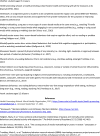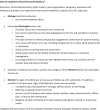International school-related sedentary behaviour recommendations for children and youth
- PMID: 35382828
- PMCID: PMC8979784
- DOI: 10.1186/s12966-022-01259-3
International school-related sedentary behaviour recommendations for children and youth
Abstract
Background: Existing sedentary behaviour guidelines for children and youth target overall sedentary behaviour and recreational screen time, without any specific recommendations regarding school-related sedentary behaviours (i.e., sedentary behaviours performed during the school day, or within the influence of school). The purpose of this paper is to describe the development of international evidence-based recommendations for school-related sedentary behaviours for children and youth, led by the Sedentary Behaviour Research Network (SBRN).
Methods: A panel of international experts was convened by SBRN in November 2020 to guide the development of these recommendations for children and youth aged ~ 5-18 years. The recommendations were informed by 1) age-relevant existing sedentary behaviour guidelines, 2) published research on the relationship between overall sedentary behaviour and health, 3) a de novo systematic review on the relationship between school-related sedentary behaviours and health and/or academic outcomes, and 4) a de novo environmental scan of the grey literature to identify existing recommendations for school-related sedentary behaviours. Draft recommendations were presented to the Expert Panel in June 2021. Following thorough discussion and modifications, updated recommendations were distributed for stakeholder feedback from July 9-26. Feedback was received from 148 stakeholders across 23 countries, leading to additional updates to the recommendations. Following further rounds of discussion and updates with the Expert Panel in August and September 2021, consensus was achieved on the final recommendations.
Results: A healthy day includes breaking up extended periods of sedentary behaviour and incorporating different types of movement into homework whenever possible, while limiting sedentary homework. School-related screen time should be meaningful, mentally or physically active, and serve a specific pedagogical purpose that enhances learning. Replacing sedentary learning activities with movement-based learning activities, and replacing screen-based learning activities with non-screen-based learning activities, can further support students' health and wellbeing.
Discussion: This paper presents the first evidence-based recommendations for school-related sedentary behaviours for children and youth. These recommendations will support the work of parents, caregivers, educators, school system administrators, policy makers, researchers and healthcare providers interested in promoting student health and academic success.
Keywords: Child health; Children and youth; Education; Guidelines; School; Screen time; Sedentary behaviour.
© 2022. The Author(s).
Conflict of interest statement
BL reports a research partnership with Active for Life, and research funding from the Canadian Institutes of Health Research to promote Canadian 24-Hour Movement Guidelines adherence. JS reports research grants from the National Health and Medical Research Council of Australia to study the efficacy, effectiveness and implementation of TransformUs program in primary schools. She reports that her spouse has developed a height-adjustable desk business for schools, although this is not currently operational. TJS reports research funding from the Levesque Foundation and the Public Health Agency of Canada to study the impacts of sedentary behaviour, and assisted the Canadian Society for Exercise Physiology in developing materials related to sedentary behaviour measurement and interventions. He has received honoraria for public talks on the health impact of sedentary behaviour, and was the sedentary behaviour content lead for Canada’s 24-Hour Movement Guidelines for Adults 18–64 years and 65+ years. JT was the Knowledge Translation Lead for the Canadian 24-Hour Movement Guidelines for Adults 18–64 years and 65+ years. MT reports publishing papers related to sedentary behaviour, and is the volunteer Chair of the Sedentary Behaviour Research Network. KW is an Associate Editor at IJBNPA, past co-chair of the International Society for Physical Activity and Health Sedentary Behaviour Council, and reports funding from the UK Medical Research Council (MC_UU_12015/3).
Figures





References
MeSH terms
Grants and funding
LinkOut - more resources
Full Text Sources
Medical

